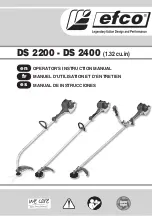
Section 5: Maintenance & Lubrication
11/2/18
32
5. Disengage power take-off, shut tractor engine off,
and remove switch key. Wait for all components to
come to a complete stop before dismounting from
tractor.
6. Inspect clutch to ensure that all scribed markings
made on the clutch plates and friction disc have
changed positions.
7.
If any two marks are still in alignment, loosen all 8
spring retaining nuts one more revolution. Make sure
the nuts have full thread engagement and then
repeat steps 4-6 one more time.
8. Skip to step 10 if all scribed marks are out of
alignment.
9. Inspect clutch and ensure that the scribed markings
made on the clutch plates have changed position.
Slippage has not occurred if any two marks on the
friction disk and plate are still aligned. A clutch that
has not slipped must be disassembled to separate
the friction disk plates. See
10. Tighten the 8 spring retainer nuts exactly two
revolutions to restore the clutch to its original
pressure setting.
11. Allow clutch to cool to ambient temperature before
operating again. Clutch is now ready for use.
12. The clutch should be checked during the first hour of
cutting and periodically each week. An additional set
of scribe marks can be added to check for slippage.
Clutch Disassembly, Inspection & Assembly
The clutch must be disassembled into its separate friction
disks if clutch run-in procedure indicated that one or more
scribed marks are still in alignment with each other. See
instructions below.
Spring Length
Figure 5-6
Clutch Disassembly
1.
If not completed, tighten each of the 8 spring retainer
nuts to their original location.
2. Measure and record distance “A” of each spring. Keep
these measurements for reassembly.
Measured and record length “A”
for each spring before
disassembling the clutch.
Use 1 1/4" (31.8mm) for “A”
dimension if measurements were
not taken before disassembling
the clutch.
35965
IMPORTANT:
After clutch run-in but before clutch
Drivelines With Slip Clutches
WARNING
!
To avoid serious injury or death:
•
Always shut tractor down using “Tractor Shutdown
Procedure” provided in this manual before dismounting
•
A slip clutch that has been in use or has slipped for as little
as only two or three seconds during run-in may be too hot
to touch. Allow a hot clutch to cool before working on it.
Cutter drive components are protected from shock loads
by a friction slip clutch. The clutch must be capable of
slippage during operation to protect the gearbox,
driveline and other drive train parts.
Friction clutches should be “run-in” prior to initial
operation and after long periods of inactivity to remove
any oxidation that may have accumulated on the friction
surfaces. Repeat “run-in” instructions at the beginning of
each season and when moisture and/or condensation
seizes the inner friction plates.
Clutch Run-In
Figure 5-5
Clutch Run-In
1.
Using a pencil or other marker, scribe a line across the
exposed edges of the clutch plates and friction disks.
2. Carefully loosen each of the 8 spring retainer nuts by
exactly 2 revolutions. It will be necessary to hold hex
end of retainer bolt in order to
count the exact
number of revolutions
.
3. Make sure the area is clear of all bystanders and
machine is safe to operate.
4. Start tractor and engage power take-off drive for 2-3
seconds to permit slippage of friction disks.
IMPORTANT:
Prior to initial operation and after 10
13693
















































